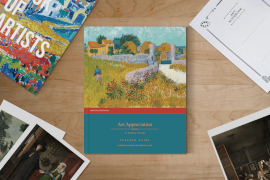Art Appreciation: A Family Study easily adapts to include many ages but is best for fifth grade and above. The course teaches art appreciation and art history, along with optional hands-on art projects and a few recipes related to art or artists. The art history taught in the course will be more easily grasped if students have previous or contemporaneous study of world history, although that’s not a prerequisite.
The course has six components, all produced by Beautiful Feet Books: a teacher guide, Book of Artists, Art Notebook, the Art Card Pack, the Art Appreciation Resource Packet, and a web links page. The Resource Packet is a downloadable PDF accessed via a QR code in the teacher guide.
The study is designed for Christian families. While much art created over the centuries has Christian themes, it can be studied in a secular fashion. However, this study takes a decidedly Christian approach, with commentary such as, “One event exerted a revolutionary effect on art: the life, death, and resurrection of Jesus Christ in the first century AD.” The next paragraph contrasts the brutality of the Roman Empire with Christians’ examples of service, forgiveness, and the extension of grace. (p. 19). Sensitive to the issue of nudity, the coursebooks show no adult nudity and just a few nude babies and cherubs. A two-page discussion of nudity in art offers some helpful guidance for addressing the topic with children.
The course is designed to take two school years, with the completion of one lesson per week. An explanation of how the course works is available both in the teacher guide and on a video (accessed via a QR code).
The course’s 64 lessons are grouped chronologically into six parts:
- Prehistoric and Ancient Art
- Medieval and Early Renaissance Art
- The Renaissance
- Post-Renaissance and the Enlightenment
- The Emergence of the Modern Era
- The Modern Era
Each lesson has several components that vary from lesson to lesson. Every lesson begins with a “Read” assignment, almost always from the 281-page Book of Artists. This beautiful hardcover book has excellent coverage of art history through text and images. You will read most, if not all, of that book over the two years. Book of Artists is written at a level best suited for students in middle school and above, and it occasionally interweaves personal stories that make it more interesting. Explanations of artworks on adjacent pages also help students better understand the text.
The one-page introduction to each of the six sections might be read from the teacher guide, but those introductions are not assigned. Instead, the teacher guide has us read introductions to the periods from Book of Artists. Interestingly, those introductions overlap a little but are quite different in both books.
Five other types of lesson components are included in the lessons besides “Read.” Sometimes all six are included, but more often, there are four or five. The other five components are:
Discuss: Discussion prompts often direct students to examine artworks featured on the 8” x 10”, full-color art cards from the Art Card Pack. Prompts in the teacher guide help students notice details and compare the featured work on the card with other artworks in the course. For instance, page 61 has students study the image of “The Parasol” by Francisco Goya for five minutes and then discuss it using three prompts:
What first catches your eye? How does your eye then move around the picture?
What other details do you notice in this painting (e.g., colors, figures, lines, etc.)?
Do you notice any similarities or dissimilarities between the figures in this painting and those in the works of Vigée Le Brun? How are the two artists’ techniques similar or different?
Some discussion prompts tie in with history, and some involve articles or videos accessed through the Beautiful Feet Books “Art Links” page. (A QR code to access the links is included on all pertinent pages of the teacher guide, and the URL is printed in the front of the guide for those who don’t want to use QR codes.)
Note that the teacher guide suggests concentrating on the Read and Discuss activities with all students and more selectively using others, but it is ultimately up to parents to determine which components to use with children of different ages.
Record: The Art Notebook included with the course is a lovely 96-page book with pages preformatted with lines, headings, and (very rarely) space for affixing an image that corresponds to a lesson. (Miniature art card images are in the Resource Packet.) It’s a “blank book with guidance.” Students fill in artwork titles, artists’ names, and their own thoughts about artworks. They select stars to rate artworks according to their own taste. Occasionally, a term, such as “vanishing point,” is printed in the book for students to define.
Play: These are the hands-on activities that relate to an artistic style or artist. While these activities are optional, they add a valuable element to the study. The projects expose students to many types of art, such as soap sculpting, fresco painting, perspective drawing, and printmaking. Projects, such as creating a self-portrait, let students choose their preferred art medium. Sometimes instructions for activities are found online through the web links.
The art supplies listed for the activities (found on page 7 and also in the Resource Packet) should be inexpensive and easy to obtain. These include watercolor paints, either acrylic or tempera paints, paintbrushes, watercolor paper, crayons or colored pencils, drawing paper, scissors, and glue. Students should curate an exhibit of their work at the end of the course.
Explore: Optional activities encourage older students to dig more deeply into topics. For instance, Explore on page 64 says,
Spend some time learning more about Romanticism by watching the video on the links page. As you do so, consider how Romanticism is similar to or different from the art movements you’ve previously learned about, particularly Rococo and Neoclassical art. Which do you prefer and why?
Rabbit Trails: Familiar to users of other Beautiful Feet Books studies, Rabbit Trails recommend mostly picture books on topics related to the lesson. For example, when students study Michelangelo’s work, the Rabbit Trail recommendation is the book Stone Giant: Michelangelo’s David and How He Came to Be by Jane Sutcliffe. Some Rabbit Trail recommendations might be especially helpful for engaging the interest of students, so be sure to check them out.
Occasional lesson elements are identified as Advanced, indicating that the content is either complex or best for mature students.
The course has neither questions requiring specific answers nor tests. Parents should evaluate student comprehension by the questions they ask and the comments they make. A major goal, especially with younger students, is to expose them to a wide range of art and ignite interest. Older students should also develop analytical skills and make connections to history as they study the featured artworks.
Summary
Art Appreciation: A Family Study offers comprehensive coverage of art history. The study purposely includes more lesson material than most families can complete, so parents can provide differentiated experiences that suit different ages and learning styles.








